In: Library

The Banff Purchase – An Exhibition of Photography in Canada
October 22, 2021The Banff Purchase
An Exhibition of Photography in Canada
John Wiley and Sons, 1979
It never ceases to amaze me how many incredible books one can find at local used bookstores and antique markets. The Banff Purchase is one of them for me. Published in 1979 to celebrate the Banff Centre’s purchase of 153 photographs by seven contemporary (at the time) Canadian photographers, the book is a treasure trove of work by the likes of Nina Raginsky, Orest Semchisen, Lynne Cohen and others. The introduction by Penny Cousineau presages her work to clarify a Canadian artistic identity, as published a quarter century later in Faking Death, previously reviewed on curated here.
Semchisen’s work is a dustier, emptier distillation of Walker Evans’ Depression Era work in the American south. Lynne Cohen is known for her large scale, uninhabited set pieces. Nina Raginsky’s playful, hand-tinted portraits often portray people who are IN the scene, but not OF the scene. Also accompanied by the works of David McMillan, Robert Boudreau, Tom Gibson and Charles Gagnon, the images that comprise The Banff Purchase are a great starting point for anyone wanting to get to know the history of Canadian photography.
Long out of print, you can find this book quite inexpensively in the aforementioned places, or online.
For more images see the full post here.
~ Mark Walton
Read More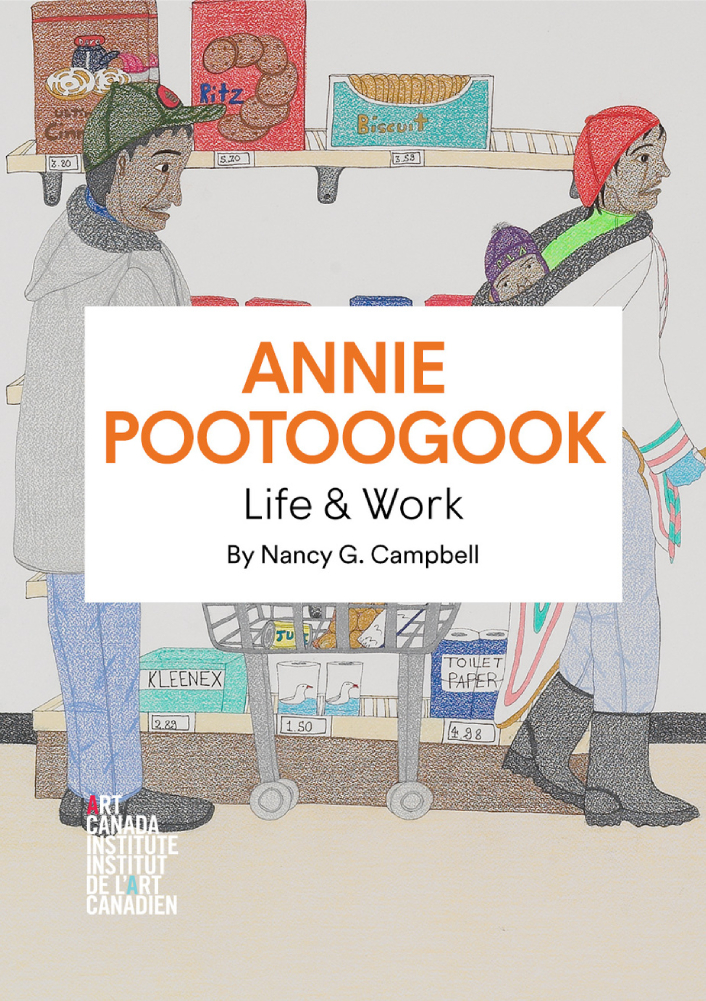
Annie Pootoogook | Life & Work
September 30, 2021Annie Pootoogook | Life & Work by Nancy G. Campbell
The Art Canada Institute has produced a number of fine books (all readily available at their site) on various artists that have informed and challenged the larger Canadian art world.
Nancy G. Campbell’s “Annie Pootoogook: Life & Work traces the artist’s life from her youth at the West Baffin Eskimo Co-operative’s Kinngait Studios, where she began drawing in 1997, predominantly in ink and crayon, to her death in 2016. The book explores how in addition to depicting scenes of everyday life in the North—including people watching TV, playing cards, shopping, or cooking dinner—Pootoogook depicted such subjects as alcoholism, domestic abuse, food scarcity, and the effects of intergenerational trauma.”
There is a certain bluntness and brutality, at times, to Pootoogook’s scenes. Campbell’s engaging but also rigorous examination of Pootoogook’s life and work (as they were, frankly, one and the same) explores how “the life of Annie Pootoogook (1969–2016) tells an important national story, and her career marks a pivotal shift in the national consciousness around contemporary Inuit art. With a keen eye for detail and fearlessness in representing daily life—the celebratory, the frightening, and the mundane—she captured the attention of Southern audiences. Although imported culture and technologies have dramatically changed Inuit life, the North has also stayed true to tradition: community, food, and language remain sources of Inuit pride. In her drawings, Annie depicted what is still valued and unique in her culture and what is changing rapidly. She had a meteoric rise in the art world that was tragically cut short when she died in 2016.”
I encountered Pootoogook’s work at the Mendel Art Gallery (now the Remai Modern) in Saskatoon in 2009. The simplicity and directness – the truth, both celebratory and unsettling – of her images resonated in that place. From the legacy of residential schools that dotted the prairies, to the Saskatoon police’s starlight tours, to the ongoing shameful dismissal of murdered and missing Indigenous women, Pootoogook – though from Cape Dorset – was very loud, in Saskatchewan, and even posthumously has a power to disrupt our assumptions and ignorance.
Annie Pootoogook: Life & Works, a publication from The Art Canada Institute, can be read here.
More about Pootoogook can be read here.
Read More

Forest for the Trees – Rita Leistner
September 16, 2021Rita Leistner
Forest for the Trees
Dewi Lewis Publishing
Rita Leistner’s latest, Forest for the Trees, is a feature documentary film and a book (published by Dewi Lewis UK), based on Rita’s fine art series The Tree Planters and Enchanted Forests, represented by the Stephen Bulger Gallery.
Rita is an award-winning multi-media artist and documentary filmmaker with a history of using photography and film to create portraits of communities in extreme conditions —such as soldiers in Iraq, female patients at psychiatric hospitals in wartime, and women wrestlers in the United States — exploring themes of purpose, struggle, and belonging.
Forest for the Trees is the story of the vast landscape of clear-cut logging and reforestation as experienced from a community of a hundred tree planters, tree planting by hand in remote locations in Canada.
Planting trees one at a time is the overarching metaphor of how we can achieve things we think are impossible: reforesting the earth one tree at a time, getting through life’s challenges one day at a time, and making a film one picture at a time.
www.forestforthetreesdocumentary.com
This recommendation appeared in the Fall 2021 – ECO ISSUE of PhotoED Magazine. If you’re looking for more Canadian photography inspiration check out PhotoED Magazine, in print + online https://www.photoed.ca
~ Rita Godlevskis
Read More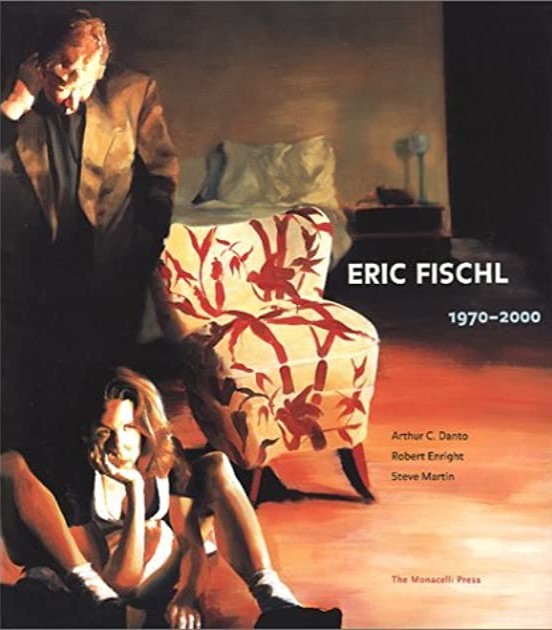
Eric Fischl 1970 – 2000
August 25, 2021Eric Fischl 1970 – 2000 (2008)
Fischl is a complicated, sometimes brilliant, sometimes less so, painter. In offering Eric Fischl 1970 – 2000, I feel that it has to be enjoyed in tandem with his biography Bad Boy : My Life On and Off the Canvas, which is unflinchingly honest about his life and his work. As you peruse the many fine images of his work in this book, I enjoyed the writings of Arthur C. Danto, was less impressed with Robert Enright or Steve Martin, but found myself more so considering Fischl’s own words: “Old-school curators and historians who attempted to predict the zeitgeist failed spectacularly. They underestimated or completely misunderstood our generation’s embrace of irony, nihilism, and the absurd sincerity of the insincere gesture….None of us knew what work would enter the lexicon, what would last. No one really knew if any of it was any good. All we knew was that we were the next generation.”
Fischl, in many ways, is one of the few American painters that were ‘stars’ of the 1980s whose work hasn’t lost some of its appeal over the nearly four decades since that unique and complicated era. From Eric Fischl 1970 – 2000: “Eric Fischl emerged in the 1980s as one of America’s most important figurative painters. His paintings, many of which show a single intense moment, compel the viewer to participate in a world of middle-class suburban ambiguity and drama. In Fischl’s engaging distinctly American canvases, narrative, morality, sexuality, and psychology are preeminent.”
The book can be purchased here, but if you’re like me and lucky enough to have an excellent library nearby – and would prefer to eschew those lumbering e-commerce monstrosities – then that is what I’d suggest (there are also many smaller, independent book stores that would be happy to order it for you, too). Fischl’s images require attention to detail and repeated considerations, and this book offers both that and some interesting, contrasting voices, as well.
Read More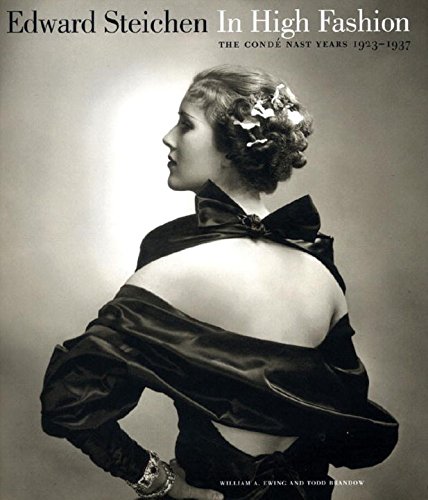
Edward Steichen – In High Fashion, The Conde Nast Years 1923-1937
September 28, 2021Edward Steichen: In High Fashion, The Conde Nast Years 1923-1937
by Todd Brandow (Author), William A. Ewing
W. W. Norton & Company
To anyone with even a smattering of knowledge of photographic history, Edward Steichen stands as a giant. He, along with Alfred Steiglitz, helped to solidify the medium’s standing as a fine art form, and embellish his own reputation in the process.
Much to the chagrin of Steiglitz and the other purists, Steichen had the audacity to construct a lucrative career for himself, as evidenced by the book Edward Steichen: In High Fashion, The Conde Nast Years 1923-1937, and became the pre-eminent photographer of fashion and celebrity culture.
I was very lucky to see the show for which this book serves as the catalogue at The Art Gallery of Ontario… actually I was lucky enough to practically LIVE at the gallery as I wore out my membership card poring over these stunning images again and again. Steichen DEFINED fashion photography as we know it, taking the work of Baron de Meyer (and others) from the end of the Belle Époque and perfecting it.
One can stare at “On George Baher’s Yacht” and “Screenwriter Anita Loos, C. 1928“ and marvel at their fluid tonality. You can see evidence of Steichen’s work to this day as photographers continue to mimic the poses and backgrounds used by him.
~ Mark Walton
Read More
Fabulous Fictions & Peculiar Practices
July 31, 2021Fabulous Fictions & Peculiar Practices by Leon Rooke and Tony Calzetta
My latest selection for From My Library again pushes some expectations, as it exists as a book proper, but also as a folio of prints with text, and – like a previous book I suggested – offers both the work of an artist (Tony Calzetta) and a writer (Leon Rooke). Fabulous Fictions & Peculiar Practices was a trade edition book published by Porpucine’s Quill in 2009 in conjunction with a limited printing of a livre d’artiste from Presswerk Editions.
Both collaborators have an entertaining irreverent humour that combine and augment each other’s practice, while never abandoning their respective formal acumen and polish (I say this having recently read Rooke’s Shakespear’s Dog which won the Governer General’s Award for Fiction in 1983, and having offered some curatorial and critical advice for Calzetta’s current exhibition, Painting and Other Fantasies). Rooke’s words are often amusing but edged: “We were down among the strippy currents basking in the afterglow of having torn ourselves apart when when my true love said, ” You should let some of your feminine side out.” I said, “If I let it out it will most certainly be slapped into prison.”
You can read more about how “Fabulous Fictions & Peculiar Practices is a fantastical literary experiment in which text and image collide to form an irreverent satire of society’s indifference to the artist” here (with another selection of the prints and accompanying text available for perusal here). If interested to purchase the book, you can do so here, and the lovely limited edition livre d’artiste (in this, the images are black and white etchings from copper plates created by the artist and handprinted by Dieter Grund at Presswerk Editions on Maidstone 100% rag 245 gm) can be obtained here. ~ Bart Gazzola
Read More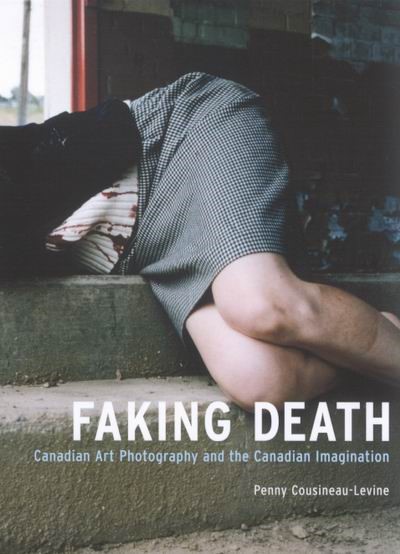
Faking Death
July 24, 2021Penny Cousineau-Levine
Faking Death
Canadian Art Photography and the Canadian Imagination
McGill-Queen’s University Press
Penny Cousineau-Levine’s “Faking Death” is considered by many to come closest to defining the characteristics of “Canadian” art; specifically the photographic arts but her conclusions can be applied to visual, performing and literary arts as well. She posits that the photographs she used for her study (all artistic photos by a select group of artists taken between 1950 and the 1990’s) are rarely about the referent… as she puts it, “a pipe in Canadian photography isn’t usually a pipe. It’s probably a crucifix”. This “dislocation” is at odds with straight American documentary photography, where the “truth” of the image is its most important characteristic.
The book, although academic in tone (indeed it was written in an attempt to describe to her university students the notion of a Canadian tradition of art), is a captivating read and draws many more fascinating conclusions. Once enlightened by her observations, you can’t help but see the characteristics she lays out in almost every piece of Canadian work.
This book is a MUST read for all Canadian artists and art lovers. It is available at McGill-Queen’s University Press. ~ Mark Walton
Read More
The AIDS Project
July 18, 2021The AIDS Project, General Idea, 1989
I’ve been having several conversations lately with people who have significant libraries of art and art related books. Most of these conversations have pertained to where they might reside, when these friends pass, or decide to divest themselves of these collections. There’s a shocking, willful poverty of places to donate these texts, and a disinterest in the history they contain, and manifest. My latest pick for From My Library is something that speaks to that, but also, in its subject matter, illuminates the forgetful vagaries of some Canadian cultural discourse, too. I’m reminded of Slavoj Žižek’s assertion that we are too often like the character in the film Memento, with lives defined by events we barely understand, can not remember nor truly desire to remember, yet are inscribed upon us in an undeniable manner. Too often, how HIV / AIDS devastated the Canadian and international cultural communities is one of those ‘forgotten’ landmarks, and is an idea I explored previously here.
In 1989, General Idea produced a limited edition publication titled The AIDS Project. It was one of many of the trio’s works about HIV / AIDS. The slim, offset printed colour booklet furthers General Idea’s appropriation / realization of Robert Indiana’s iconic LOVE images into AIDS, and has an accompanying text by Allan Schwartzman. This was produced as a project of the Gershon Iskowitz Foundation: and the colours and vibrancy of the images are just as striking now as over three decades ago, when it was published. What was once perhaps audacious in redefining Indiana’s LOVE is more iconic, more mature and significant, than the naive pop art which General Idea sampled. Finding this in my friend’s library was a reminder, and as she gifted it to me, is an encapsulation of memories and the past that perhaps at some point I’ll pass on too, to keep the stories and remembrance alive. ~ Bart Gazzola
Read More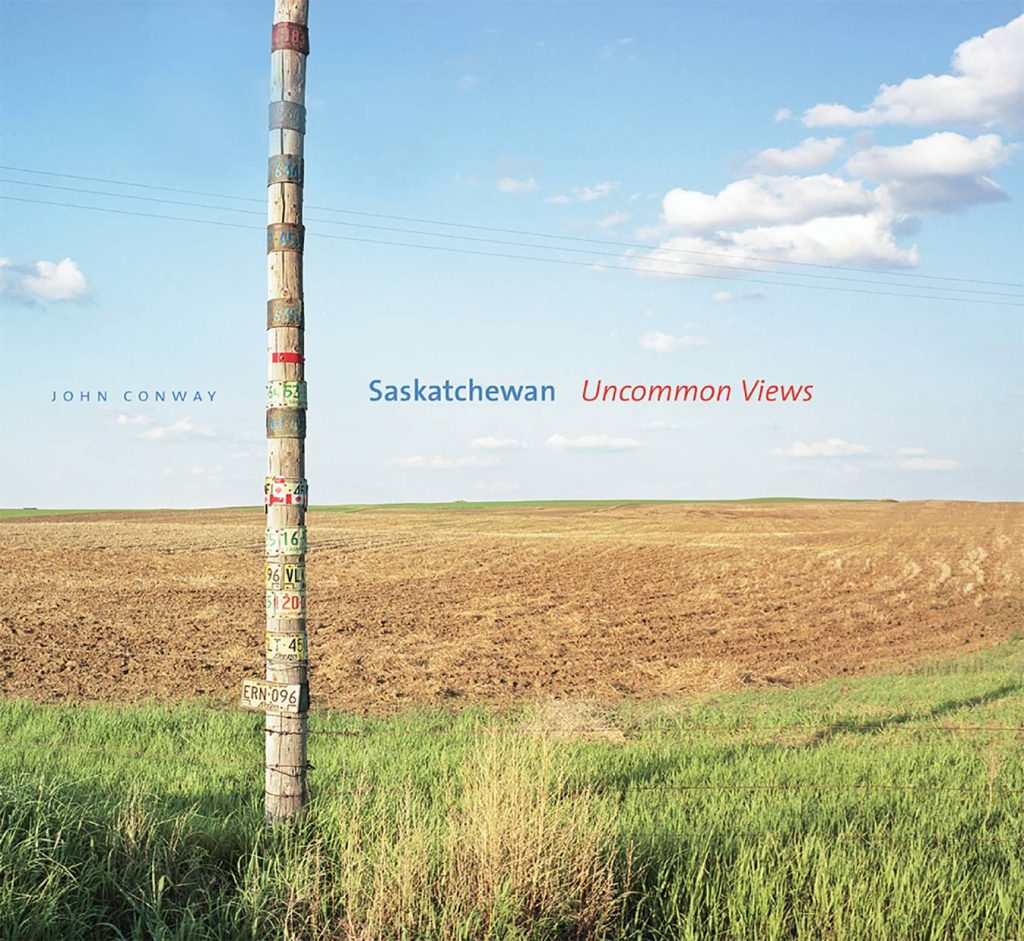
Saskatchewan: Uncommon Views
June 9, 2021Saskatchewan: Uncommon Views, John Conway, 2005
Full disclosure: I know John Conway, as our tenures in ‘next year’s country’ of Saskatchewan overlapped, and I obtained a copy of Uncommon Views when it first came out. Saskatchewan visual culture is rife with stereotypical landscapes, but Conway offered something different, whether it be the vibrant variety of colours or the almost irreverently morose tone. Conway would leave Saskatchewan for B.C. not long after this book was published, and I would depart ten years later, so in some ways Uncommon Views is a memento, or perhaps a memento mori. John’s words resonate with me: ‘Collectively, the photographs tell something of the story of this place that was my home for much of my adult life. Themes from this story of Saskatchewan are: Promise, Survival, Sentimentality, New Jerusalem, Quirky, and Quietus.’
Accompanying texts from Sharon Butala, David Carpenter and Helen Marzolf all offer a considered response to Conway’s images, by writers who understand that “the plain is a metaphysical landscape…where there is almost nothing to see, there [one] sees the most.” (Wright Morris)
Originally published by the University of Alberta Press (a prophet is without honour in their own country, ahem, as ironically the year of publication was Saskatchewan’s centennial year), Uncommon Views is now out of print, but copies can be purchased from the artist. ~ Bart Gazzola
Read More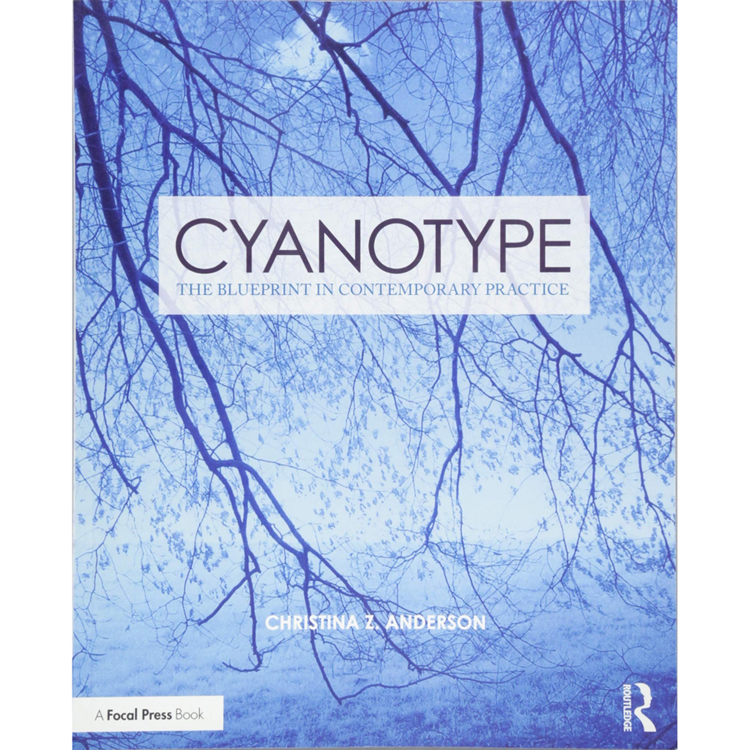
Christina Z. Anderson – Cyanotype: The Blueprint in Contemporary Practice
June 25, 2021Christina Z. Anderson
Cyanotype: The Blueprint in Contemporary Practice
A Focal Press Book, Routledge
Cyanotype: The Blueprint in Contemporary Practice is THE book you need if you want to learn how to create stunning cyanotype prints. Written by Christina Z. Anderson and available online, it offers detailed notes on formulas, papers, digital negatives and the actual process itself, as well as highlighting the work of contemporary cyanotype artists. Anderson is also the author of similar books on gum prints and salted paper prints. I’ve included 2 of my test images using her processes below. ~ Mark Walton
Read More
Recent Comments